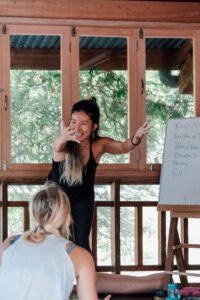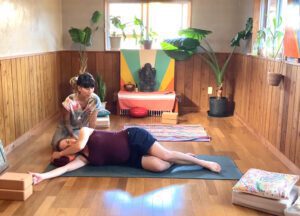I saw an instagram post that was sent to me the other day from a “friend.” I put air quotes because I’ve never met her. I’ve known her only online for over 3 years. She knows and doesn’t know me. I know and don’t know her. But one thing for sure, she supports me in some of my darkest times. I share things I haven’t shared to some of my closest people. Real relationships online seems impossible but I am sure I am not the only one.
When Covid happened and everyone went online, there was a big divide in yoga community. Should we jump right on this opportunity and finally work on YouTube or InstaLive? Or should we jump the high hurdles and make in-person class even more special?
Yoga at the time was already starting to go online. Big corporations like Alo Yoga had hundreds and thousands of yoga videos for their members. At the same time, there was a great resistance to yoga going online. People prided themselves as the real, old school yoga teachers if their students had to be face to face, and receiving hands-on assisting. It was as if modern yoga community was deciding whether online yoga could be an authentic and honorable thing to do.


Nonetheless, it is safe to say that we were all “forced” to go online. Those prided themselves as real and authentic vowing to provide only in-person classes shut the door to, reluctantly and awkwardly, go online.
Now, post-Covid, online yoga lessons continue. I, for one, resisted going online for a while seeing how I lived on a tiny island with shaky Wifi and power in Indonesia, it was a great concern for me whether I have a steady Wifi during live, or if people really respond to my classes online.
But here we are. I teach almost half online and half in-person. I’m on an island called Okinawa, off of main land Japan so if my students happen to be on this island or are willing to travel, they come to our space to do yoga with me. But some students of mine are on different islands or in different time zones. We meet online to practice yoga. And let me tell you, yes, there is a difference between online and in-person. But the impact that yoga has on my students is real in both ways.
Physically I am not with you but spiritually, I am 100% there with you. There are things more easily shared online than in in-person class. The screen between my students and I create the boundary we need to articulate what we want to say more clearly. Whereas in in-person, I work a lot with my students’ habitual pattern to have to smile or respond to what I say. Especially during Yoga Nidrā, the students often feel badly that they fell asleep when that is a natural effect of the practice.
I believe that the teaching of yoga surpasses changes of the world. It can change shapes and formats in which yoga is being taught but as long as the teacher commits to stewardship of yogic teachings and pass along the authentic teachings, yoga lives on.
In-person classes are great and we know it. But next time, do not hesitate to contact the teacher you find online and start your lessons. It can be a lifelong teacher-student relationship.
